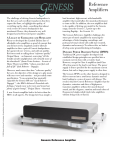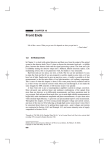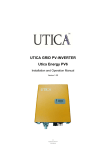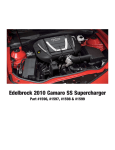Download Genesis Advanced Technologies Genesis Reference-Series Amplifier None User's Manual
Transcript
654 S Lucile St Seattle, WA 98108 Tel: (206) 762 8383 Fax: (206) 762 8389 Owners Manual Genesis Reference-Series Amplifier Version 2.0 September 2008 Copyright Genesis Advanced Technologies All Rights Reserved absolute fidelity® OWNERS MANUAL Genesis Reference Amplifier Contents Set-up and Safety Information ........................................................................ 3 Unpacking and Setting Up .......................................................................... 3 Safety Information ....................................................................................... 4 Set-up and Operation ..................................................................................... 6 Speaker Connections.................................................................................. 6 Input Connections ....................................................................................... 6 Playing Music .............................................................................................. 7 About Your Amplifier....................................................................................... 9 Introduction.................................................................................................. 9 Design and Construction............................................................................. 9 Dynamic Power Delivery Supply (DPDS)................................................ 9 Silent Running Voltage Supply.............................................................. 11 Resonance and Vibration Control ......................................................... 12 Acoustic Suspension System ................................................................ 13 Specifications (Each) .................................................................................... 14 A Message from Genesis The transparency, detail retrieval, macro- and micro-dynamics, and wide frequency extension of Genesis loudspeakers place great demands on the quality of amplification. Hence, to match the Genesis loudspeakers, the Genesis Reference Series of amplifiers was created as the finest musical amplifiers available. Please write the serial number and purchase details of your Genesis Reference Amplifier here for future reference. Serial Nos.: __________________ Bought at: ___________________ ____________________________ Date: _______________________ Address: ____________________ The Genesis Reference Amplifier, together with a pair of Genesis loudspeakers, will give your entire music collection a whole new life. In a well set-up system, it is capable of transporting the musical performance into your room. The hiss and hum normally associated with vacuum tubes are completely absent, while retaining the richness and rightness of the best of this genre of amplifiers. Transistor etch and harshness are completely absent, while retaining the slam and control of the best of solid-state. During development, we benchmarked against the best cost-noobject amplifiers – both solid-state and vacuum tube. While we were intent on developing a value-priced product, quality has not been scaled down. Hand-selected, precisely matched components are used throughout: copper-core silver wire with Teflon insulation is used in the entire signal and power path. Each and every unit is completely hand-assembled in the USA, and burned-in before final testing and measurement. The result of all this obsessive attention to detail is a fabulously musical power amplifier capable of driving almost any loudspeaker in the world. The state of the environment is also taken care of with extremely high efficiency, instant warm up, and a simple, functional, and elegant design.1 _________________________ Tel: ________________________ Before using this unit, please take the time to carefully review the safety instructions and operating information contained in this Owner’s Manual. Becoming familiar with your new amplifier and the correct operating procedures will help assure you of safe usage, reliable operation, and maximum musical enjoyment. 1 Some of the inspiration for the GR-Amp came from the sci-fi movies “Silent Running” and “Max Headroom: 20 Minutes into the Future”. Genesis Reference Amplifier Owners Manual Ver 2.0 2 Set-up and Safety Information Now that you have your new amplifier, we realize that you can't wait to hook it up and start playing! However, please read this set-up guide and safety information before you proceed. Unpacking and Setting Up The amplifier is likely to come in parts – the amplifier module, an acoustic suspension, and a power transformer (an auxiliary power supply upgrade called the Maximum Dynamic Headroom Reservoir is also available) unless your dealer has assembled it for you. So, some assembly may be needed before you can start playing. It is important that this product is never used near water or sources of water. Avoid bathrooms, washbowls, kitchen sinks, swimming pools, etc. Carefully remove the various parts of the amplifier package from the cartons and unwrap it. The suspension system will need to be assembled to the amplifier chassis. You will use the hex key and four hex screws supplied to do this. Place the amplifier chassis top down on a clean surface. Place the suspension frame on the shock absorbers so that the holes of the shock absorbers are aligned with the matching holes on the frame. The suspension frame “points” forwards so that the tip of the triangle faces to the front of the amplifier, and the round hole is in the front. Use the hex screws and the supplied hex key to secure the suspension frame to the shock absorbers. Do not overtighten the screws. Turn the amplifier over, screw in the steel spike bolts into the threaded holes in each corner of the suspension frame. Screw them in so that the spikes protrude by about a third of an inch (8mm) from the bottom of the frame and no more. The Acoustic Suspension will allow the amplifier to be placed directly on the floor, or on any piece of furniture or equipment rack. The amplifier should not be subject to vibration of any sort. Do not place them directly in front of, or on top of your loudspeakers. Despite the vibration and resonance control measures already taken in the Genesis Reference Amplifier, we are not able to completely eliminate all incoming vibration. Genesis Reference Amplifier Owners Manual Ver 2.0 3 Once you decide on the placement of the amplifier module, and connect the power transformer using the supplied Power Umbilical, locate the power transformer module as far away from the listener as possible. The Power Umbilical will only go in one way so the assembly should be obvious. Align the plugs to the like-colored sockets, insert and twist until the lock “clicks”. If you have the optional Maximum Dynamic Headroom Reservoir (MDHR), 2 place that on top of the amplifier module , and connect the two using the short Power Umbilical supplied with the MDHR. Then, connect the power transformer module to the MDHR. Before you plug the power cord in the power transformer, please make sure that you have the power transformer with the proper voltage for the country you are in. Taiwan, Japan and North America will require the 115V version. Most European countries and other Asian countries will require the 230V version. Also, make sure that you have the appropriate power transformer for the amplifier model that you have. Connect the loudspeakers to the 5-way binding posts using good quality loudspeaker cables, and the appropriate RCA or XLR interconnects to the pre-amplifier. Safety Information 1. Never try to disassemble the amplifier as you may be exposed to dangerous voltages. Even after turning the amplifier off and unplugging it from the wall socket, it will retain a lethal electrical charge for a very long time. There is huge energy storage in the power supply capacitors (and even more so in the MDHR!!). 2. Do not attempt to modify the amplifier. The device has been tested and adjusted for optimal operation and should give you years of trouble-free service. 3. Do not connect/disconnect the power supply and power transformer from the amplifier module without turning the amplifier off first. 2 Note that the rubber feet of the MDHR may mark the top of the amplifier module, but this is easily cleaned off using rubbing alcohol or “Goof Off”. However, please note that the placement and material of the rubber feet will serve to further damp the top plate of the amplifier module. Do not be tempted to use cones or other forms of isolation between the MDHR and the amplifier module. The top of the amplifier chassis holds the signal path. Genesis Reference Amplifier Owners Manual Ver 2.0 4 4. Before turning the amplifier on, both inputs and outputs should be properly connected. Do not run the amplifier without the appropriate loudspeakers connected to it. 5. While the Genesis Reference Amplifier runs very cool due to its high efficiency, some ventilation and airflow at the faceplate is necessary for reliable operation. Do not obstruct the vents at the sides of the chassis, or the holes on the bottom cover. 6. Do not connect or disconnect the loudspeakers from the amplifier while it is playing. Turn the amplifier off, and wait a few seconds before making any connections. Genesis Reference Amplifier Owners Manual Ver 2.0 5 Set-up and Operation Speaker Connections A pair of 5-way insulated binding posts is provided on the rear of your amplifier. While this allows bare wire to be used, we recommend that firstly banana plugs, or secondly spade lugs be used instead of bare wire. Make sure that your speaker cables are firmly connected to the correct speaker connections. The binding posts are ETI CablePods™ for improved signal transfer, enhanced sonic performance, and a faster, more direct connection. The positive (signal) terminal is identified by the red ring on the base; and the negative (return) terminal is identified by the black ring on the base. If you are using banana plugs, you may have to remove the little plastic covers (if installed) on the top of each CablePod™. If you are using spade lugs, unscrew the binding posts, insert the spades, and hand tighten. Do not use pliers or other tools to tighten the binding posts as you may strip the plastic threads on the posts. These ETI CablePods are designed to fully tighten without the use of tools. DO NOT SHORT THE TERMINALS TOGETHER AND DO NOT GROUND THE LOUDSPEAKER TERMINALS Unlike many other Class D amplifiers, the output terminals of the GR-Amp do not “float” at a significant voltage above ground potential – which makes the GR-Amp useable with all loudspeakers, including those with built-in powered subwoofers and electrostatic designs. However, this does NOT mean that you can ground the negative terminal of the speaker outputs. Do NOT even attempt to short the two negative (return) terminals together. The amplifier CAN NOT be bridged for higher power. Input Connections Use a pair of high-quality interconnects to hook up the output of your preamplifier to the input of the GR-Amp. The balanced-input GR-Amp is a fully balanced, differential amplifier, and hence, a true-balanced source is crucial for top performance. The balanced input of the GR-Amp uses the standard configuration for the XLR input of pin 2 “hot”. Pin 1 is signal ground, and pin 3 is the signal “return”. Genesis Reference Amplifier Owners Manual Ver 2.0 6 The use of single-ended to balanced converters that simply short pin 3 to ground is not recommended as performance will be compromised. Some form of balancing adapter may be used, but the performance of the GR-Amp will be limited by the sonic quality of the device. A high quality single-ended to balanced converters such as the FM Acoustics FM214 can be used between your single-ended preamplifier and the GR-Amp. The single-ended version of the GR-Amp converts a single-ended input into the true balanced signal required by the amplifier at a very slight reduction in transparency. The single-ended version of the GR-Amp is ground-lifted. Hence, care may be needed in the grounding scheme of your entire system. Playing Music Make sure that your amplifier is properly connected to a high-current power outlet. Before you turn the amplifier on, check that the speaker connections and inputs are properly hooked up and tightened. Make sure that you turn down the volume control on your preamplifier first before turning your amplifier on. Locate the power toggle switch on the back next to the power umbilical inlet and flick it upwards to turn the amplifier ON. In less than a second, you will hear a faint click to indicate that the soft-start 3 circuit has engaged and the LED(s) under the amplifier will glow. Unlike most power amplifiers, the power toggle switch on the back of the amplifier is not the actual power switch. We have found that most toggle or rocker switches degrade the power supply path. Hence, the power toggle is a lowvoltage, low-power trigger that switches in a high-current hermetically sealed relay with silver contacts that is the actual power switch. Hence, if the amplifier does not switch on or off, resist flicking the switch up and down quickly. Wait a couple of seconds before trying the switch again. Give your amplifier a warm-up period of at least 10 seconds for the circuits to stabilize before attempting to play any music. Because of a special “stay warm” circuit, as long as the amplifier is plugged in continuously, it will warm 3 Note that there are two blue LEDs under the 360W amplifier module, and one blue LED under the 180W amplifier module. Genesis Reference Amplifier Owners Manual Ver 2.0 7 up almost instantly, and be ready to play the moment you turn it on. The “stay warm” circuits consume about as much power as a night-light. To turn the amplifier back to stand-by, flick the power toggle up. When you know that you will not be using the amplifier for a long period of time (for example when you go on a business trip or a vacation), please unplug the power transformer at the wall outlet. Genesis Reference Amplifier Owners Manual Ver 2.0 8 About Your Amplifier Introduction The Genesis Reference Amplifier uses proprietary designs and circuits, high quality components, and state-of-the-art Class D amplifier modules to deliver sonic performance rivaling amplifiers costing much, much more. The design brief was to deliver a load-invariant, wide-bandwidth amplifier that would deliver the musicality, emotion, and tonal colors of a low-powered valve amplifier with the reliability, power, and control of a high power solid-state design. A valve amplifier matched with an appropriate loudspeaker can produce a sound that we can only call magic. The hard, brittle, and edgy presentation of many transistor amplifiers is contrasted with the rich, lush and silky sound of the tube amplifier. Often, valve amplifiers offer much better imaging and sound stage presentation compared to an equivalently priced solid-state amplifier. It is more musical, and the performance seems almost alive. However, a solid-state amplifier often offers better control and dynamics, is easier to set-up and to own (without having to change tubes every so often). Except for Class A solid state amplifiers, they also run much cooler and consume less electricity than valve amplifiers. Solid-state amplifiers are also able to drive a far wider range of loudspeakers than most valve amplifiers. The Genesis Reference Amplifier (GR-Amp) offers the best of both worlds. Design and Construction The GR-Amp challenges the status quo of music amplifiers by marrying the advantages of tube (emotion, imaging, soundstage, and portrayal of tonal colors) with solid state (control, dynamics and accuracy). It uses a modified Class D power amplifier module with ground-breaking power supply technologies, and resonance and vibration control to achieve this. Dynamic Power Delivery Supply (DPDS) Traditional DC power supplies developed with established design principles are usually specified into a constant current draw with a resistive load. However, except for Class A amplifiers (and Class AB at low power), the load is not linear. The power supply is hence specified for the maximum current drawn, but such a huge power supply is often slow. Resulting in a dark, brooding, muscle-bound sound. The Genesis DPDS, on the other hand, is designed to deliver current into a non-linear, dynamic musical load, leading to a sense of power with finesse. The result is that the Genesis Reference Amplifier has the dynamics, Genesis Reference Amplifier Owners Manual Ver 2.0 9 extension and drive of high-power transistor amplifiers without the musclebound sound, and the elegance, emotion and tonal colors of flea-powered single-ended triode vacuum tube amplifiers without being weak or flaccid. The origins of the DPDS comes from the principles of tube amplifier design – some of the qualities of tube amplifiers were as much to do with power supply design as the choice of tubes over transistors. Because of the high voltages involved, tube amplifiers use relatively small capacitors and chokes to produce smooth DC power. Transistor amps use cheaper, larger, and lower-voltage electrolytic capacitors to do much the same job. From this we discover a very simple fact, smaller capacitors usually sound better. This is not only speculation, there is good science to predict that the high frequency performance of large capacitors to be poor. There are lots of very small solid-state amplifiers that have excellent sound. They all had tiny power supplies, and the smaller the power supply, the “faster” they sounded. On the other hand, very large power amplifiers with huge capacitors, or even large banks of smaller capacitors in their power supplies tended to sound dark and slow. The DPDS in the simplest explanation uses the frequency distribution of music, and the Fletcher Munson curves to predict the required power delivery to play back music. Then, it uses a Class D amplifier module as a “perfect music-driven faucet” to deliver current to the connected loudspeakers. This is the issue of speed vs power. The sprinter is not able to sustain the delivery of power for very long, but the marathon runner is not able to deliver very quick bursts of speed. The DPDS is like a relay team with sprinters, medium-distance, and long distance runners in the team. Thus, it is able to deliver high power, as well as very quick bursts of speed. Such a “relay team” is what gives the Genesis Reference Amplifier the excellent micro-dynamics, tonal contrasts and timbre textures of lowpowered amplifiers, and yet is able to deliver huge dynamics and the sustained deep bass of muscle amps. The optional Maximum Dynamic Headroom Reservoir extends this ability down to loudspeaker impedances of 1 ohm and below by extending the relay team, and adds proprietary resonance control circuitry to ensure that the “baton handover” from one team member to the next is handled as smoothly as possible. This results in increased dynamics from having more current Genesis Reference Amplifier Owners Manual Ver 2.0 10 available into lower impedance loads and better micro-dynamics – one listener described it as “having cream in your coffee instead of non-fat soy”. Silent Running Voltage Supply4 We recognized that published specifications for noise rejection of opamps and even discrete small-signal amplification circuits did not always tell the whole story. The problem is that Power Supply Rejection Ratio, or PSRR, is specified at one frequency – usually 1kHz, but the truth is that this rapidly gets worse as the frequency rises. For the GR-Amp, a low-current regulated voltage supply was developed that has broad bandwidth noise rejection so that incoming noise does not intrude on your music. Like the DPDS, the SRVS is also based on the design of power supplies for tube amplifier design. Because of the high voltages involved, tube amplifiers use relatively small capacitors and chokes to produce smooth DC power. The electronics used for regulation have to be noiseless and fast. Generally noiseless is not a problem, fast is a great problem. Most commercial regulators are good for about 100 kHz. Most chokes are good for at least 1 MHz. The electronic regulator used in the GR-Amp exceeds the specifications of an excellent choke. It is an exceedingly fast Audio Band Noise Rejection (over –90dB flat all the way up to 40kHz) discrete circuit and not a generic design. Spectrum analysis up to 16 MHz implies a very high bandwidth, as there is no apparent degradation at that frequency. The circuit is of low enough impedance to outperform commercial regulators by at least 10 dB. This is despite the fact that no loop feedback is used in this circuit. To avoid any speculation, it is not a shunt device, it is not a capacitative multiplier, and it does not employ chokes. 4 Genesis would like to credit Engr. Nigel Pearson for the design of the SRVS. Genesis Reference Amplifier Owners Manual Ver 2.0 11 It will not surprise many to know that the avoidance of loop negative feedback is the key to this design. Having established a design, the components used were individually selected by extensive and laborious listening test. A discrete design allowed that as each component can be hand picked to get the optimum result. Every component on the design was individually chosen, as was the grounding paths. Resonance and Vibration Control With all the emphasis on reducing noise from the power supply coming into the amplifier, it makes no sense if the amplifier itself creates vibration or generates radio frequency interference and electro-magnetic interference. Hence, one key feature of the GR-Amp is the outboard power transformer. There is no way to eliminate hum and vibration from the transformer. This is because even for the best-built transformer, the incoming 50Hz or 60Hz in the coils will shake the steel in the transformer core. Moreover, if the incoming power is not a perfect sinusoidal waveform, the transformer will rattle and buzz even more. For example, a single switched mode power supply in the same electrical circuit as the transformer will cause asymmetric compression of the power waveform. Moreover, noise-generating devices such as light dimmers, electric curling irons, microwave ovens, etc. can also cause the transformer to vibrate at those noise frequencies. Capacitative coupling between the primary and secondary windings of the transformer will result in high frequency noise bleeding through from the input to the output. A phenomenon that we noted in the design of the transformer is that when the coils are wound so that the transformer does not emit an audible hum, the transformer will vibrate and heat up even more. It is intuitive that the incoming sine wave needs to be dissipated in some way – in the form of sound, heat, or vibration. With the transformer moved outside of the chassis, the Genesis Reference Amplifier has a much quieter environment in which to operate. To further reduce the vibration/resonance within the chassis, the signal and power circuits are isolated from each other. The signal circuits are softy “hung” using a neoprene “hammock” from the top cover of the chassis, while the power circuits are stiffly mounted on the bottom plate using plastic posts. This choice of differently compliant mounting is because of the different susceptibility of the two different circuits to different frequencies of vibration and resonance. Genesis Reference Amplifier Owners Manual Ver 2.0 12 Acoustic Suspension System A dedicated suspension system completes the resonance and vibration control design of the Genesis Reference Amplifier. It also facilitates the easy placement and location of the amplifier. Designed like the suspension system of a race car, the acoustic suspension is made of a solid acrylic suspension frame, neoprene shock absorbers, and steel spikes. It isolates the amplifier from floor- or structure-borne vibrations, and yet at the same time allows any vibration in the amplifier chassis to be “sunk” to ground. The function of the steel spike is to have a low-impedance point to transfer all frequencies to ground. This is possible because the contact at the point of the spike is smaller than a ½ wavelength of the frequencies of vibration transmitted. Using a steel cup under the spike will defeat this function and as this will only allow passing frequencies have a ½ wavelength larger than the diameter of the steel cup, which is far larger than the point of the spike. Hence, if the amplifier is to be placed on a hardwood floor, and you do not want to mark the floor, use a thin disc of copper (a copper penny will do) under each spike. The weight of the amplifier on the spike will deform the disc and create a small indentation. The other side of the indentation will form a little nipple to couple to the hardwood floor. Alternatively, use a little square of aluminum foil that is at least 4 layers thick. Other features that have been incorporated include: • A grounded Faraday Cage steel chassis for RFI and EMI rejection improves micro-dynamics, and tonal colors and contrast. • Internal wiring using silver strands with a copper core and PTFE dielectric. The silver strands are wound so tightly together that the strands “imprint” on each other and combine to act almost as a solidcore wire. Thus, the internal wiring has the qualities of both solidcore as well as stranded wire. This wiring is used in all signal and power paths. • Having critical components toleranced to less than +/- 1% results in a sense of aliveness and ease in the music. • Special circuitry to “keep things warm” without wasting a lot of electricity means that your system is ready for you to listen to whenever you are. • High-power, high current relays to switch power instead of typical rocker or toggle switches result in minimal degradation of the power supply path. Genesis Reference Amplifier Owners Manual Ver 2.0 13 Specifications (Each) • Rated Power Output: 180w or 360w RMS (@ 4ohm) Current limited to 20amps for 20ms • Frequency Response: 10Hz ~ 50kHz +0dB/-3dB • Power Bandwidth: 18Hz to 36kHz • Input Impedance: 100k Ohms (Balanced or Single-ended) • Damping: 2,000 minimum at 4 ohms • Gain: 26dB • Inputs: Balanced XLR or Single-ended RCA • Output: ETI CablePods™ 5-way binding posts Genesis Reference Amplifier Owners Manual Ver 2.0 14


























